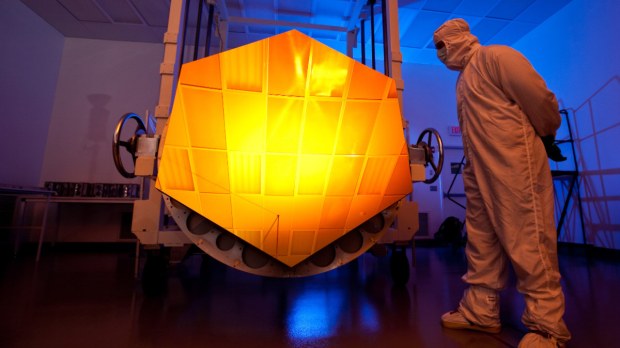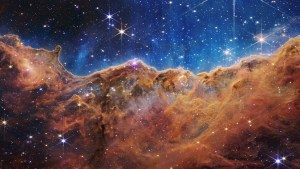Astronomers looked back to the edge of the universe to see the earliest galaxies — and found mature galaxies instead.
That was the surprising news from the James Webb Space Telescope (JWST) last month. Joel Leja, assistant professor of astronomy and astrophysics at Penn State, and a co-author of the February 22 paper in the leading scientific journal Nature that discussed this discovery, said:
“We expected only to find tiny, young, baby galaxies at this point in time, but we’ve discovered galaxies as mature as our own in what was previously understood to be the dawn of the universe.”
What?
What does that mean, especially for believers who see in the beginning of the universe the hand of God in action? Does it mean that the universe might be older than we think? Does it mean astronomers are clueless about how galaxies form? Does it mean that everything you learned in school about the formation of the universe is wrong?
Possibly. But what it really means is that the JWST is doing what it was designed to do. It is making discoveries.
Maybe this discovery will indeed turn out to be something that upends our understanding of the early universe, or maybe it won’t. But if it does, that should not be too surprising. This wouldn’t be the first time our understanding of the universe has been upended.
Consider James Webb—the man, not the telescope. He was the head of NASA in the 1960s. When he was born, in 1906, astronomers did not really know that other galaxies even existed. There was just our Milky Way.
The Milky Way had been known, in some sense, since human beings first looked at the night sky. Anyone who looks up at the sky on a clear, moonless night, in a place where there is not a bunch of artificial lighting around (and in the days before James Webb was born, that was almost everywhere), will see a band of white light crossing the sky. This white path across the sky is called the “Milky” (that is, white) “Way” (that is, path). In fact, the term “galaxy” comes from the Greek word γαλαξίας (galaxías), meaning “milky.”
(Incidentally, another term for the white path in the sky was the “Camino de Santiago”—the Way of St. James!)
After the telescope was invented at the start of the 17th century, astronomers discovered that the white path was composed of countless faint stars. It became clear that our sun was amid a vast, flattened congregation of stars. The word “galaxy” came to mean this starry congregation—and to mean something like what we today understand the word to mean.
But as far as anyone knew, there was just one galaxy. Mind you, astronomers had observed spiral-shaped objects called “nebulae” and had speculated that they could be other galaxies, but when Isaac Roberts obtained one of the first high-quality photographs of one of those nebulae in 1888, he was convinced that it was merely a forming solar system, not a galaxy:
Here we (apparently) see a new solar system in the process of condensation from a nebula—the central sun is now seen in the midst of nebulous matter which in time will be either absorbed or further separated into rings.
Agnes Clerke, who served as a sort of one-woman information hub for the astronomical community in the late 19th century (incidentally, she was Catholic) put it this way in 1890:
The question of whether nebulae are external galaxies hardly any longer needs discussion. It has been answered by the progress of discovery. No competent thinker, with the whole of the available evidence before him, can now, it is safe to say, maintain any single nebula to be a star system of coordinate rank with the Milky Way.
The “fact” that the universe consisted merely of the Milky Way and whatever fuzzy gas clouds might be found within it was one of those things that “everybody knows.”
Therefore, when James Webb was born, astronomers thought the universe consisted of one galaxy—the Milky Way. They also thought the universe never changed, that it had no beginning and would never end. But during his lifetime (Webb died in 1992) astronomers came to understand just the opposite. The universe contains hundreds of billions of other galaxies, and they indicate that the universe had a beginning, and has changed (and expanded) over time.
What we thought we knew
A central figure who helped upend everything we thought we knew was a Belgian Catholic priest, Fr. Georges Lemaître. In the 1920s, when Webb was a young man, Fr. Lemaître combined the new Theory of General Relativity that had just been proposed by Albert Einstein with new observations of those “nebulae”/“galaxies.” Fr. Lemaître came up with what we today call the “Big Bang Theory.”
Lemaître’s idea was not universally welcomed. He was a priest. He was proposing a beginning to the universe (echoes of Genesis?). He had called his idea the “primeval atom,” but another astronomer, Fred Hoyle, coined the term “Big Bang,” and not as a compliment.
Some, notably in the Soviet Union, claimed that Lemaître was trying to “strengthen religious views on the structure of the Universe.”
“Falsifiers of science,” one Soviet official said, “want to revive the fairy tale of the origin of the world from nothing.” The prominent physicist David Bohm (1917-1992) described supporters of the Big Bang theory as people who would “effectively turn traitor to science, and discard scientific facts to reach conclusions that are convenient to the Catholic Church.”
Debate over the “Big Bang” idea ebbed and flowed over James Webb’s career. With the passage of time, however, more and more evidence accumulated in favor of Fr. Lemaître’s theory. Today it is so well accepted by the astronomical community, in fact, that the JWST was built to be specifically “tuned” to Fr. Lemaître’s ideas.
If the universe had a beginning, and is expanding, then the light waves emitted by the most distant objects in the universe should be “stretched” by that expansion so much that they are now longer-wavelength “infrared” waves. JWST with its big golden mirror is designed to see those distant objects in “infrared” light. Because of the time it takes light to travel such distances, it sees those objects as they appeared in the early days of the universe—showing us, we hope, the first stars and galaxies to form after Fr. Georges Lemaître’s “Big Bang.”
But as the “Big Bang Theory” became accepted by astronomers, another surprising sort of upending took place. This theory, which had been developed by a priest and had once been derided as nothing more than an effort to replace science with religion and make the Catholic Church happy, came instead to be seen by many people as somehow as opposed to Scripture.
These people thought that somehow the Big Bang could serve as a replacement for the “Let there be light” of Genesis. Atheists who wanted to replace God with Science proclaimed that physics, not God, could create the universe. Fundamentalist believers who feared that their faith was threatened by science that did not describe the beginning of the universe exactly as Genesis does, ironically agreed with the atheists (and forgot that the older theory of a beginningless universe really disagreed with Genesis)!
But perhaps the most insidious error comes from those who think that the Big Bang confirms Genesis. Genesis started with the phrase “let there be light,” after all. Isn’t that just the burst of energy that we see in the Big Bang?
It’s insidious because it seems so reasonable. But in fact, it makes the same mistake that the atheists and fundamentalists make. It conflates “what happened” in the universe at the tiniest early moments of space and time — the Big Bang — with the bigger picture of God who created not just a burst of energy at one place and one time, but who created space and time itself.
Not (entirely) what we expected
As the news from the Webb telescope about the earliest galaxies reminds us, our ideas of the Big Bang are hardly complete and perfect. In general, our outline seems to be all right; the images we see from long ago and far away are indeed coming to us in infrared light as the Big Bang predicts. But in other ways we are learning that the way the stars and galaxies evolved is different from what we once expected.
And that’s only to be expected. The whole point of building a telescope like Webb is not to confirm what we already know, but to alert us to things we may not even have known we didn’t know. Our goal is precisely to challenge, indeed to threaten, our previous understanding.
It’s not that what we believe, either in science or faith, is always wrong. But it is always incomplete. Only when we have the courage to have what we believe challenged, can we allow our understanding to grow. And in that way, ultimately, both our faith in our science and our faith in our faith can become stronger.
God created the universe … deliberately, systematically, beautifully, finding it good at every step. That is the lesson of Genesis. And that’s true, no matter what theory science may come up with to describe how it was done. It will remain true a thousand years from now, when these new images from Webb will be considered quaint and naïve.
In the meanwhile, let’s enjoy what we are learning, delight in the surprises, and embrace the beauty of the universe that our latest telescopes provide us. After all, the Heavens proclaim the glory of God!



